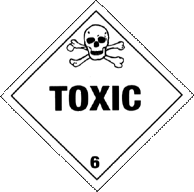Dicrotophos
- Dimethyl cis-2-dimethylcarbamoyl-1-methylvinyl phosphate
- (E)-3 (Dimethyloamino)-1-methyl-3-oxoprop-1-enyl dimethyl phosphate

Dicrotophos | |
| |
| Formula | C8H16NO5P |
| Structure |  |
| Description | A yellow to brown liquid with a mild ester odor. |
| Uses | Systemic insecticide and acaricide for cotton, apples & other crops. |
| Registry Numbers and Inventories. | |
| CAS | 141-66-2 |
| EC (EINECS/ELINCS) | 205-494-3 |
| EC Index Number | 015-073-00-4 |
| EC Class | Very toxic; Toxic; Dangerous for the Environment |
| RTECS | TC3850000 |
| RTECS class | Agricultural Chemical and Pesticide; Mutagen; Reproductive Effector |
| UN (DOT) | 3018 |
| Merck | 12,3137 |
| Beilstein/Gmelin | 1880084 |
| EPA OPP | 35201 |
| Swiss Giftliste 1 | G-4040 |
| Austrailia AICS | Listed |
| Properties. | |
| Formula | C8H16NO5P |
| Formula mass | 237.19 |
| Boiling point, °C | 400 |
| Vapor pressure, mmHg | 0.00001 |
| Density | 1.216 g/cm3 (20 C) |
| Solubility in water | Miscible |
| Refractive index | 1.468 (20 C) |
| Partition coefficient, pKow | -0.49 |
| Hazards and Protection. | |
| Storage | Stable when stored in glass or polyethylene containers below 40 C, but decomposes completely after 31 days at 75 C or 7 days at 90 C. Formulations on common solid carriers are unstable. |
| Handling | All chemicals should be considered hazardous. Avoid direct physical contact. Use appropriate, approved safety equipment. Untrained individuals should not handle this chemical or its container. Handling should occur in a chemical fume hood. |
| Protection | Wear appropriate eye protection and protective clothing to prevent skin and eye contact. Facilities for quickly drenching the body should be provided within the immediate work area for emergency use where there is a possibility of exposure. |
| Respirators | Wear positive pressure self-contained breathing apparatus (SCBA). |
| Small spills/leaks | (Non-Specific -- Organophosphorus Pesticide, Liquid, n.o.s.) Do not touch spilled material; stop leak if you can do so without risk. Use water spray to reduce vapors. Small spills: absorb with sand or other noncombustible absorbent material and place into containers for later disposal. Small dry spills: with clean shovel place material into clean, dry container and cover; move containers from spill area. Large spills: dike far ahead of spill for later disposal. Keep unnecessary people away; isolate hazard area and deny entry. Stay upwind; keep out of low areas. Ventilate closed spaces before entering them. Remove and isolate contaminated clothing at the site. |
| Stability | No data. |
| Incompatibilities | Incompatible with the following: Metals Corrosive to cast iron, mild steel, brass & stainless steel.]. |
| Fire. | ||||
| Flash Point,°C | 93 | |||
| Fire fighting | (Non-Specific -- Organophosphorus Pesticide, Liquid, n.o.s.) Move container from fire area if you can do so without risk. Fight fire from maximum distance. Dike fire control water for later disposal; do not scatter the material. Wear positive pressure breathing apparatus and special protective clothing.(Non-Specific -- Organophosphorus Pesticide, Liquid, n.o.s.) Extinguish with dry chemical, carbon dioxide, water spray, fog, or foam. | |||
| Fire potential | This material may burn but does not ignite readily. | |||
| Hazards | Containers may explode when heated. | |||
| Combustion products | Fire may produce irritating, corrosive and/or toxic gases. | |||
| Health. | |
| Exposure limit(s) | TLV: ppm; 0.25 mg/m3 (as TWA) (skin) (ACGIH 1997). NIOSH REL: TWA 0.25 mg/m3 skin |
| Poison_Class | 2 |
| Exposure effects | Headache, dizziness, muscle spasms, and profound weakness are common. Alterations of the level of consciousness, seizures, and coma may occur. Seizures may be more common in children. Peripheral neuropathy of the mixed sensory-motor type may be delayed in onset by 6 to 21 days. Recovery may be slow or incomplete. 1. Dicrotophos did not induce delayed neurotoxicity in the standard hen assay. Dicrotophos was not teratogenic in mice, but was teratogenic in birds. <br>Most organophosphates have not been teratogenic in experimental animals, but some have caused lower fetal or birth weights and/or higher neonatal mortality. <br>Sporadic reports of human birth defects related to organophosphates have not been verified. |
| Ingestion | Vomiting, diarrhea, fecal incontinence, and abdominal pain may occur. |
| Inhalation | Dyspnea, rales, bronchorrhea, or tachypnea may be noted. Pulmonary edema may occur in severe cases. |
| Skin | Sweating is a consistent but not universal sign. |
| Eyes | Constriction of the pupil, tearing, and blurred vision are common. Prolonged dialation of the pupils may occur in severe poisonings. Opsoclonus has occurred rarely. Excessive salivation commonly occurs. |
First aid |
|
| Ingestion | Seek medical assistance. |
| Inhalation | Move victim to fresh air. Apply artificial respiration if victim is not breathing. Do not use mouth-to-mouth method if victim ingested or inhaled the substance; induce artificial respiration with the aid of a pocket mask equipped with a one-way valve or other proper respiratory medical device. Administer oxygen if breathing is difficult. |
| Skin | Remove and isolate contaminated clothing and shoes. Immediately flush with running water for at least 20 minutes. For minor skin contact, avoid spreading material on unaffected skin. |
| Eyes | Immediately flush with running water for at least 20 minutes. |
| Transport. | ||
| UN number | 3018 |  |
| Response guide | 152 | |
| Hazard class | 6.1 | |
| Packing Group | I; II; III | |
| USCG CHRIS Code | DRT | |